
Atlas of Peculiar Galaxies
Encyclopedia
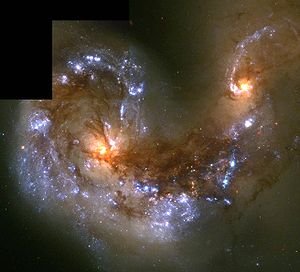
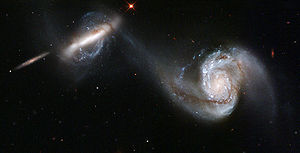
.jpg)
.jpg)
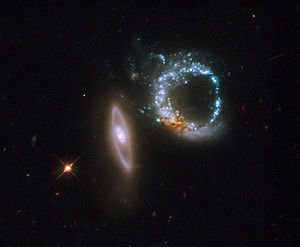
Astronomical catalog
An astronomical catalog or catalogue is a list or tabulation of astronomical objects, typically grouped together because they share a common type, morphology, origin, means of detection, or method of discovery...
of peculiar galaxies produced by Halton Arp
Halton Arp
Halton Christian Arp is an American astronomer. He is known for his 1966 Atlas of Peculiar Galaxies, which catalogues many examples of interacting and merging galaxies...
. A total of 338 galaxies are presented in the atlas, which was originally published in 1966 by the California Institute of Technology
California Institute of Technology
The California Institute of Technology is a private research university located in Pasadena, California, United States. Caltech has six academic divisions with strong emphases on science and engineering...
.
The primary goal of the catalog was to present photographs of examples of the different kinds of peculiar structures found among nearby galaxies. Arp realized that the reason why galaxies formed into spiral
Spiral galaxy
A spiral galaxy is a certain kind of galaxy originally described by Edwin Hubble in his 1936 work The Realm of the Nebulae and, as such, forms part of the Hubble sequence. Spiral galaxies consist of a flat, rotating disk containing stars, gas and dust, and a central concentration of stars known as...
or elliptical
Elliptical galaxy
An elliptical galaxy is a galaxy having an approximately ellipsoidal shape and a smooth, nearly featureless brightness profile. They range in shape from nearly spherical to highly flat and in size from hundreds of millions to over one trillion stars...
shapes was not well understood. He perceived peculiar galaxies as small "experiments" that astronomers could use to understand the physical processes that distort spiral or elliptical galaxies. With this atlas, astronomers had a sample of peculiar galaxies that they could study in more detail. The atlas does not present a complete overview of every peculiar galaxy in the sky but instead provides examples of the different phenomena as observed in nearby galaxies.
Because little was known at the time of publication about the physical processes that caused the different shapes, the galaxies in the atlas are sorted based on their appearance. Objects 1-101 are individual peculiar spiral galaxies or spiral galaxies that apparently have small companions. Objects 102-145 are elliptical and elliptical-like galaxies. Individual or groups of galaxies with neither elliptical nor spiral shapes are listed as objects 146-268. Objects 269-327 are double galaxies. Finally, objects that simply do not fit into any of the above categories are listed as objects 332-338. Most objects are best known by their other designations, but a few galaxies are best known by their Arp numbers (such as Arp 220
Arp 220
Arp 220 is the result of a collision between two galaxies which are now in the process of merging. Located 250 million light-years away in the constellation Serpens, it is the 220th object in Halton Arp's Atlas of Peculiar Galaxies.-Features:...
).
Today, the physical processes that lead to the peculiarities seen in the Arp atlas are now well understood. A large number of the objects are interacting galaxies, including M51 (Arp 85), Arp 220
Arp 220
Arp 220 is the result of a collision between two galaxies which are now in the process of merging. Located 250 million light-years away in the constellation Serpens, it is the 220th object in Halton Arp's Atlas of Peculiar Galaxies.-Features:...
, and the Antennae Galaxies (NGC 4038/NGC 4039, or Arp 244)
Antennae Galaxies
The Antennae Galaxies are a pair of interacting galaxies in the constellation Corvus. They are currently going through a phase of starburst. They were discovered by William Herschel in 1785...
. A few of the galaxies are simply dwarf galaxies that do not have enough mass
Mass
Mass can be defined as a quantitive measure of the resistance an object has to change in its velocity.In physics, mass commonly refers to any of the following three properties of matter, which have been shown experimentally to be equivalent:...
to produce enough gravity to allow the galaxies to form any cohesive structure. NGC 1569 (Arp 210)
NGC 1569
NGC 1569 is a dwarf irregular galaxy in Camelopardalis. While this faint galaxy is not a popular amateur astronomy target, it is well studied by professional astronomers, who are interested in the history of star formation within the galaxy. The galaxy is relatively nearby. Consequently, the...
is an example of one of the dwarf galaxies in the atlas. A few other galaxies are radio galaxies. These objects contain active galactic nuclei that produce powerful jets of gas called radio jets. The atlas includes the nearby radio galaxies M87 (Arp 152)
Messier 87
Messier 87 is a supergiant elliptical galaxy. It was discovered in 1781 by the French astronomer Charles Messier, who cataloged it as a nebulous feature. The second brightest galaxy within the northern Virgo Cluster, it is located about 16.4 million parsecs from Earth...
and Centaurus A (Arp 153)
Centaurus A
Centaurus A is a prominent galaxy in the constellation of Centaurus. There is considerable debate in the literature regarding the galaxy's fundamental properties such as its Hubble type and distance...
.
Notable Arp galaxies
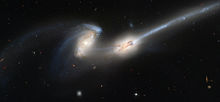
.jpg)
| Arp Number | Name | Magnitude Apparent magnitude The apparent magnitude of a celestial body is a measure of its brightness as seen by an observer on Earth, adjusted to the value it would have in the absence of the atmosphere... |
Notes |
|---|---|---|---|
| 26 | Pinwheel Galaxy Pinwheel Galaxy The Pinwheel Galaxy is a face-on spiral galaxy distanced 21 million light-years away in the constellation Ursa Major, first discovered by Pierre Méchain on March 27, 1781, and communicated to Charles Messier who verified its position for inclusion in the Messier Catalogue as one of its final... (M101) |
+7.5 | spiral galaxy |
| 37 | Messier 77 Messier 77 Messier 77 is a barred spiral galaxy about 47 million light-years away in the constellation Cetus. Messier 77 is an active galaxy with an Active Galactic Nucleus , which is obscured from view by astronomical dust at visible wavelengths... |
+8.9 | radio galaxy |
| 41 | NGC 1232 | +9.8 | spiral galaxy |
| 76 | Messier 90 Messier 90 Messier 90 is a spiral galaxy about 60 million light-years away in the constellation Virgo. It was discovered by Charles Messier in 1781.- Membership of the Virgo Cluster :... |
+9.5 | spiral galaxy |
| 77 | NGC 1097 NGC 1097 NGC 1097 is a barred spiral galaxy about 45 million light-years away in the constellation Fornax. As of 2006, three supernovae have been observed in NGC 1097.... |
+9.5 | galaxy interacting with its satellite |
| 85 | Whirlpool Galaxy Whirlpool Galaxy The Whirlpool Galaxy is an interacting grand-design spiral galaxy that is estimated to be 23 ± 4 million light-years from the Milky Way Galaxy. in the constellation Canes Venatici... (M51) |
+8.4 | galaxy interacting with its satellite |
| 116 | Messier 60 Messier 60 Messier 60 is an elliptical galaxy approximately 55 million light-years away in the constellation Virgo.-History:... |
+8.8 | colliding galaxies |
| 152 | Virgo A (M87) | +8.6 | elliptical galaxy |
| 153 | Centaurus A Centaurus A Centaurus A is a prominent galaxy in the constellation of Centaurus. There is considerable debate in the literature regarding the galaxy's fundamental properties such as its Hubble type and distance... (NGC 5128) |
+6.6 | radio galaxy in a collision? |
| 188 | Tadpole Galaxy Tadpole Galaxy The Tadpole Galaxy is a disrupted barred spiral galaxy located 400 million light years from Earth toward the northern constellation Draco. Its most dramatic features are a trail of stars about 280 thousand light-years long and massive, bright blue star clusters.It is hypothesized that a more... |
+14.4 | galaxy finishing merging |
| 242 | Mice Galaxies Mice Galaxies NGC 4676, or the Mice Galaxies, are two spiral galaxies in the constellation Coma Berenices. About 290 million light-years away, they are presently in the process of colliding and merging... |
+14.7 | colliding galaxies |
| 244 | Antennae Galaxies Antennae Galaxies The Antennae Galaxies are a pair of interacting galaxies in the constellation Corvus. They are currently going through a phase of starburst. They were discovered by William Herschel in 1785... |
+10.3 | colliding galaxies |
| 317 | Messier 65 Messier 65 Messier 65 is an intermediate spiral galaxy about 35 million light-years away in the constellation Leo. It was discovered by Charles Messier in 1780. M65, M66, and NGC 3628 comprise the famous Leo Triplet, a small group of galaxies.-Discovery:M65 was discovered by Charles Messier and included in... |
+9.2 | spiral galaxy |
| 319 | NGC 7320 NGC 7320 NGC 7320 is a spiral galaxy in the Stephan's Quintet. However, it is not an actual member of the galaxy group, but a much closer line-of-sight galaxy at a distance of about 40 million light years. Other galaxies of Stephan's Quintet are some 300 million ly distant.... |
+15 | galaxy in colliding group |
| 337 | Cigar Galaxy (M82) | +8.6 | starburst galaxy |
Low surface brightness galaxies
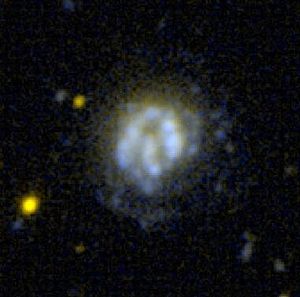
| Arp Number | Common Name | Notes |
|---|---|---|
| 1 | NGC 2857 | Sc spiral galaxy |
| 2 | UGC 10310 | |
| 3 | Arp 3 | |
| 4 | Arp 4 | |
| 5 | NGC 3664 | |
| 6 | NGC 2537 NGC 2537 NGC 2537 is a blue compact dwarf galaxy in the constellation Lynx. This is also known as Bear's Paw Galaxy, Arp 6, and Mrk 86. It belongs to the iE class of Blue Compact Dwarf classification, which is described as galactic spectra with an underlying smooth elliptical Low Surface Brightness... |
|
Galaxies with split arms
This category contains spiral galaxies with arms that split into two separate parts.| Arp Number | Common Name | Notes |
|---|---|---|
| 7 | Arp 7 | |
| 8 | NGC 497 | |
| 9 | NGC 2523 | |
| 10 | UGC 1775 | Contains an off-center nucleus |
| 11 | UGC 717 | |
| 12 | NGC 2608 NGC 2608 NGC 2608 is a barred spiral galaxy located 93 million light-years away in the constellation Cancer . It is 62,000 light-years across; about 60% of the width of the Milky Way... |
|
Galaxies with detached segments
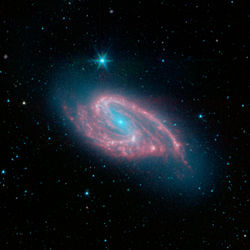
| Arp Number | Common Name | Notes |
|---|---|---|
| 13 | NGC 7448 | |
| 14 | NGC 7314 NGC 7314 NGC 7314 is a spiral galaxy located in the constellation Piscis Austrinus. It is a Seyfert galaxy.Walter Scott Houston describes its appearance in small telescopes:... |
|
| 15 | NGC 7393 | |
| 16 | M66 Messier 66 Messier 66 is an intermediate spiral galaxy about 36 million light-years away in the constellation Leo. It was discovered by Charles Messier in 1780... |
|
| 17 | UGC 3972 | |
| 18 | NGC 4088 NGC 4088 NGC 4088 is an intermediate spiral galaxy in the constellation Ursa Major. The galaxy forms a physical pair with NGC 4085, which is located 11′ away.-Disk Structure:... |
|
Three-armed spiral galaxies
Usually, most spiral galaxies contain two clearly defined spiral arms, or they contain only fuzzy filamentary spiral structures. Galaxies with three well-defined spiral arms are rare.| Arp Number | Common Name | Notes |
|---|---|---|
| 19 | NGC 145 NGC 145 NGC 145, also known as Arp 19, is an irregular galaxy in Cetus most well noted for its three spiral arms.... |
|
| 20 | UGC 3014 | |
| 21 | Arp 21 | |
One-armed spiral galaxies
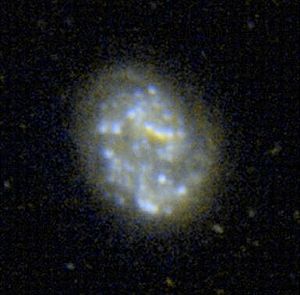
| Arp Number | Common Name | Notes |
|---|---|---|
| 22 | NGC 4027 NGC 4027 NGC 4027 is a barred spiral galaxy approximately 83 million light-years away in the constellation Corvus. It is also a peculiar galaxy because one of its spiral arms goes out more than the other... |
|
| 23 | NGC 4618 NGC 4618 NGC 4618 is a distorted dwarf galaxy in the constellation Canes Venatici. The galaxy is formally classified as a Sm galaxy, which means that its structure vaguely resembles the structure of spiral galaxies... |
Interacting with NGC 4625 NGC 4625 NGC 4625 is a distorted dwarf galaxy in the constellation Canes Venatici. The galaxy is formally classified as a Sm galaxy, which means that its structure vaguely resembles the structure of spiral galaxies... |
| 24 | NGC 3445 | |
Spiral galaxies with one heavy arm
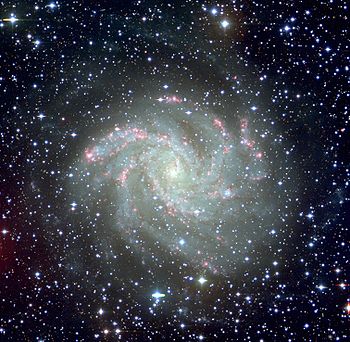
M101
M101 or M-101 may refer to:* Myasishchev M-101T Gzhel, an aircraft produced in Russia* Messier 101, or the Pinwheel Galaxy, a spiral galaxy in the constellation Ursa Major* M101 howitzer, a 105 mm light howitzer...
and NGC 6946
NGC 6946
NGC 6946, , is an intermediate spiral galaxy about 22 million light-years away, on the border between the constellations Cepheus and Cygnus. It was discovered by William Herschel on September 9, 1798...
) are simply asymmetric spiral galaxies, NGC 6365 is an interacting pair of galaxies where one of the two galaxies is viewed edge-on and just happens to lie where the spiral arm for the other face-on galaxy would be visible.
| Arp Number | Common Name | Notes |
|---|---|---|
| 25 | NGC 2276 | |
| 26 | M101 | Face-on spiral galaxy Spiral galaxy A spiral galaxy is a certain kind of galaxy originally described by Edwin Hubble in his 1936 work The Realm of the Nebulae and, as such, forms part of the Hubble sequence. Spiral galaxies consist of a flat, rotating disk containing stars, gas and dust, and a central concentration of stars known as... with five notable companion galaxies |
| 27 | NGC 3631 | |
| 28 | NGC 7678 | |
| 29 | NGC 6946 NGC 6946 NGC 6946, , is an intermediate spiral galaxy about 22 million light-years away, on the border between the constellations Cepheus and Cygnus. It was discovered by William Herschel on September 9, 1798... |
|
| 30 | NGC 6365 | Interacting pair of galaxies, with one galaxy viewed edge-on |
Integral sign spiral galaxies
These are galaxies that look like a stretched-out S shape (or like the integral sign used in calculusCalculus
Calculus is a branch of mathematics focused on limits, functions, derivatives, integrals, and infinite series. This subject constitutes a major part of modern mathematics education. It has two major branches, differential calculus and integral calculus, which are related by the fundamental theorem...
). Some objects, such as IC 167
IC 167
IC 167 is a barred spiral galaxy in the constellation of Aries. It was first reported by Bigourdan in 1891 and included in Dreyer's first Index Catalogue.-Galaxy group information:...
, are simply ordinary spiral galaxies viewed from an unusual angle. Other objects, such as UGC 10770, are interacting pairs of galaxies with tidal tails that look similar to spiral arms.
| Arp Number | Common Name | Notes |
|---|---|---|
| 31 | IC 167 IC 167 IC 167 is a barred spiral galaxy in the constellation of Aries. It was first reported by Bigourdan in 1891 and included in Dreyer's first Index Catalogue.-Galaxy group information:... |
|
| 32 | UGC 10770 | |
| 33 | UGC 8613 | |
| 34 | NGC 4615 | |
| 35 | UGC 212 | |
| 36 | UGC 8548 | |
Spiral galaxies with low surface brightness companions
Many of these spiral galaxies are probably interacting with the low surface brightness galaxies in the field of view. In some cases, however, it may be difficult to determine whether the companion is physically near the spiral galaxy or whether the companion is a foreground/background source or a source on the edge of the spiral galaxy.| Arp Number | Common Name | Notes |
|---|---|---|
| 37 | M77 Messier 77 Messier 77 is a barred spiral galaxy about 47 million light-years away in the constellation Cetus. Messier 77 is an active galaxy with an Active Galactic Nucleus , which is obscured from view by astronomical dust at visible wavelengths... |
|
| 38 | NGC 6412 | |
| 39 | NGC 1347 | |
| 40 | IC 4271 | |
| 41 | NGC 1232 NGC 1232 NGC 1232 is an intermediate spiral galaxy about 60 million light-years away in the constellation Eridanus.It is dominated by millions of bright stars and dark dust, in spiral arms rotating about the center. Open clusters containing bright blue stars are sprinkled along these spiral arms, with dark... |
|
| 42 | NGC 5829 NGC 5829 NGC 5829 is a galaxy in the constellation Boötes. Together with IC 4526, it forms galaxy group Arp 42. Also, it is one of 5 members of galaxy group Hickson 73 .-References:* *... |
|
| 43 | IC 607 | |
| 44 | IC 609 | |
| 45 | Arp 45 | Galaxy triplet |
| 46 | UGC 12665 | |
| 47 | Arp 47 Arp 47 The designation Arp 47 represents two interacting galaxies, in the constellation Puppis:-References:*... |
|
| 48 | Arp 48 | |
Spiral galaxies with small high surface brightness companions
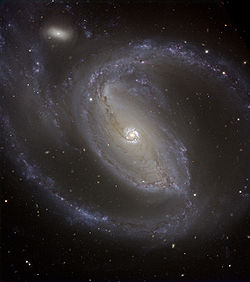
| Arp Number | Common Name | Notes |
|---|---|---|
| 49 | NGC 5665 NGC 5665 -References:***... |
|
| 50 | IC 1520 | |
| 51 | Arp 51 | |
| 52 | Arp 52 | |
| 53 | NGC 3290 | |
| 54 | Arp 54 | |
| 55 | UGC 4881 | |
| 56 | UGC 1432 UGC 1432 UGC 1432 or Arp 56 is a 15th magnitude spiral galaxy approximately 360 million light years distant in the constellation Aries. It is around 100 thousand light years across, similar in size to the Milky Way Galaxy. Arp 56 is characterised by the presence of a small, bright companion galaxy with... |
|
| 57 | Arp 57 | |
| 58 | UGC 4457 | |
| 59 | NGC 341 | |
| 60 | Arp 60 | |
| 61 | UGC 3104 | |
| 62 | UGC 6865 | |
| 63 | NGC 2944 | |
| 64 | UGC 9503 | |
| 65 | NGC 90 | |
| 66 | UGC 10396 | |
| 67 | UGC 892 | |
| 68 | NGC 7757 | |
| 69 | NGC 5579 NGC 5579 -References:* * *... |
|
| 70 | UGC 934 | |
| 71 | NGC 6045 | |
| 72 | NGC 5994, NGC 5996 | |
| 73 | IC 1222 | |
| 74 | Arp 74 | |
| 75 | NGC 702 | |
| 76 | M90 Messier 90 Messier 90 is a spiral galaxy about 60 million light-years away in the constellation Virgo. It was discovered by Charles Messier in 1781.- Membership of the Virgo Cluster :... |
|
| 77 | NGC 1097 NGC 1097 NGC 1097 is a barred spiral galaxy about 45 million light-years away in the constellation Fornax. As of 2006, three supernovae have been observed in NGC 1097.... |
|
| 78 | NGC 772 NGC 772 NGC 772 is an unbarred spiral galaxy approximately 130 million light-years away in the constellation Aries. It is notable for possessing a single elongated outer spiral arm, which has likely arisen due to tidal interactions with nearby galaxies... |
|
Spiral galaxies with large high surface brightness companions
.jpg)
NGC 5195
NGC 5195 is a dwarf galaxy that is interacting with the Whirlpool Galaxy . Both galaxies are located approximately 25 million light-years away in the constellation Canes Venatici...
. The interaction has distorted the shape of both galaxies; the spiral arm pattern has been enhanced in the larger spiral galaxy, and a bridge of stars and gas has formed between the two galaxies. Many of the other galaxies in this category are also connected by bridges.
| Arp Number | Common Name | Notes |
|---|---|---|
| 79 | NGC 5490C | |
| 80 | NGC 2633 | |
| 81 | NGC 6621, UGC 11175, NGC 6622 | |
| 82 | NGC 2535 NGC 2535 NGC 2535 is an unbarred spiral galaxy in the constellation Cancer that is interacting with NGC 2536. The two galaxies are listed together in the Atlas of Peculiar Galaxies as an example of a spiral galaxy with a high surface brightness companion.... , NGC 2536 NGC 2536 NGC 2536 is a barred spiral galaxy in the constellation Cancer that is interacting with NGC 2536. The two galaxies are listed together in the Atlas of Peculiar Galaxies as an example of a spiral galaxy with a high surface brightness companion.... |
|
| 83 | NGC 2799, NGC 3800 | |
| 84 | NGC 5394, NGC 5395 | |
| 85 | The Whirlpool Galaxy (M51) | |
| 86 | NGC 7752, NGC 7753 | |
| 87 Arp 87 Arp 87 is a pair of interacting galaxies NGC 3808A and NGC 3808B.It is situated about 300 million light-years from Earth in the Leo constellation.-External links:** at BadAstronomy.com... |
NGC 3808A NGC 3808A NGC 3808A is a galaxy that is interacting with NGC 3808B, creating a pair of galaxies called Arp 87.-External links:* * *... , NGC 3808B NGC 3808B NGC 3808B is a galaxy that is interacting with NGC 3808A, creating a pair of galaxies called Arp 87.-External links:* * *... |
|
| 88 | Arp 88 | |
| 89 | NGC 2648 | |
| 90 | NGC 5929 NGC 5929 NGC 5929 is a Seyfert galaxy in the constellation Boötes. The pair of galaxies, NGC 5929 and NGC 5930, areinteracting.-External links:*... , NGC 5930 NGC 5930 NGC 5930 is a galaxy in the constellation Boötes. Interacting Galaxies, NGC 5930 and NGC 5929.-References:**... |
|
| 91 | NGC 5953, NGC 5954 | |
Spiral galaxies with elliptical companions
Like the spiral galaxies with high surface brightness companions, most of these spiral galaxies are clearly interacting systems. Tidal tails and bridges are visible in many of the images.| Arp Number | Common Name | Notes |
|---|---|---|
| 92 | NGC7603 | |
| 93 | NGC 7284, NGC 7285 | |
| 94 | NGC 3226 NGC 3226 NGC 3226 is a dwarf elliptical galaxy that is interacting with the spiral galaxy NGC 3227. The two galaxies are one of several examples of a spiral with a dwarf elliptical companion that are listed in the Atlas of Peculiar Galaxies... , NGC 3227 NGC 3227 NGC 3227 is a spiral galaxy that is interacting with the dwarf elliptical galaxy NGC 3226. The two galaxies are one of several examples of a spiral with a dwarf elliptical companion that are listed in the Atlas of Peculiar Galaxies... |
|
| 95 | IC 4461, IC 4462 IC 4462 -References:* *... |
|
| 96 | Arp 96 | |
| 97 | UGC 7085A | |
| 98 | Arp 98 | |
| 99 | NGC 7547, NGC 7549, NGC 7550 | Galaxy triplet |
| 100 | IC 18, IC 19 | |
| 101 | UGC 10164, UGC 10169 | |
Elliptical galaxies connected to spiral galaxies
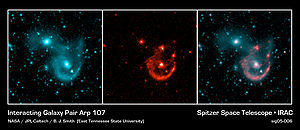
| Arp Number | Common Name | Notes |
|---|---|---|
| 102 | Arp 102 | |
| 103 | UGC 10586 | Galaxy triplet |
| 104 Arp 104 Arp 104, also known as Keenan's system, is entry 104 in Halton Arp's Atlas of Peculiar Galaxies catalog for spiral galaxy NGC 5216 and globular galaxy NGC 5218. The two galaxies are joined by a bridge of galactic material spanning 22 000 light years.In 1790 William Herschel discovered the... |
NGC 5216, NGC 5218 | |
| 105 | NGC 3561 NGC 3561 NGC 3561 is a pair of interacting galaxies NGC 3561A and NGC 3561B within the galaxy cluster Abell 1185. Its common name is "the Guitar" and contains a small tidal dwarf galaxy known as Ambartsumian's Knot.-External links:*... |
|
| 106 | NGC 4211 | |
| 107 | UGC 5984 | |
| 108 | Arp 108 | |
Elliptical galaxies repelling spiral arms
Based on the description of these objects, it appears that Arp originally thought that the elliptical galaxies were pushing away spiral arms in companion galaxies. However, the tidal spiral arms may actually look distorted because of the interaction. Some of these "repelled" spiral arms are on the opposite side of the spiral galaxy from the elliptical galaxy. Simulations have shown that such features can be formed through gravitational interactions alone; no repelling forces are needed.| Arp Number | Common Name | Notes |
|---|---|---|
| 109 | UGC 10053 | |
| 110 | Arp 110 | |
| 111 | Arp 111 | Galaxy group |
| 112 | NGC 7805, NGC 7806 | |
Elliptical galaxies close to and perturbing spiral galaxies
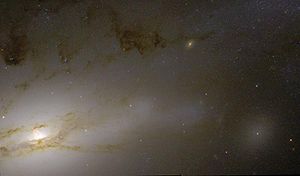
| Arp Number | Common Name | Notes |
|---|---|---|
| 113 | NGC 70 | Part of a group of galaxies |
| 114 | NGC 2276, NGC 2300 | |
| 115 | UGC 6678 | Galaxy triplet |
| 116 | Messier 60 Messier 60 Messier 60 is an elliptical galaxy approximately 55 million light-years away in the constellation Virgo.-History:... , NGC 4647 |
|
| 117 Arp 117 Arp 117 is a pair of galaxies in the constellation Boötes, composed of the two separate galaxies IC 983 and IC 982.... |
IC 982 IC 982 IC 982 is a galaxy in the constellation Boötes. It is part of the Arp 117 pair of galaxies with IC 983.-References:* * * * *... , IC 983 IC 983 IC 983 is a galaxy in the constellation Boötes. It is part of the Arp 117 pair of galaxies with IC 982.-References:* * * *... |
|
| 118 | NGC 1141, NGC 1142 | |
| 119 | Arp 119 | |
| 120 | NGC 4435, NGC 4438 | |
| 121 | Arp 121 | |
| 122 | NGC 6040 | |
| 123 | NGC 1888, NGC 1889 | |
| 124 | NGC 6361 | |
| 125 | UGC 10491 | |
| 126 | UGC 1449 | |
| 127 | NGC 191 | Actually interacting S0 galaxy and spiral galaxy |
| 128 | UGC 827 | |
| 129 | UGC 5146 | |
| 130 | IC 5378 | |
| 131 | Arp 131 | |
| 132 | Arp 132 | |
Galaxies with Nearby Fragments
| Arp Number | Common Name | Notes |
|---|---|---|
| 133 | NGC541 | |
| 134 | Messier 49 Messier 49 Messier 49 is an elliptical / lenticular galaxy about 49 million light-years away in the constellation Virgo. The galaxy was discovered by Charles Messier in 1771.-Supernovae:... |
|
| 135 | NGC 1023 | |
| 136 | NGC 5820 NGC 5820 NGC 5820 is a galaxy in the constellation Boötes. It lies near a similar massed galaxy, NGC 5821, at the same redshift.With a diameter of 7.1 million light years, it is larger than the similar-mass IC 1101.- References :***... |
|
Material emanating from elliptical galaxies
Arp thought that the elliptical galaxies in this category were ejecting material from their nuclei. Many of the pictures could be interpreted that way. However, these objects are actually a mixture of other phenomena. For example, NGC 2914 (Arp 137) is merely a spiral galaxy with faint spiral arms, and NGC 4015 (Arp 138) is an interacting pair of galaxies where one galaxy is an edge-on spiral galaxy. Some objects, such as NGC 2444 and NGC 2445 (Arp 143), are systems that contain "ring galaxies", which are created when one galaxy (the elliptical galaxies in these examples) passes through the disk of another. This passage causes a gravitational wave in which gas first falls inward and then propagates outward to form the ring structure.| Arp Number | Common Name | Notes |
|---|---|---|
| 137 | NGC 2914 | Spiral galaxy with faint spiral arms |
| 138 | NGC 4015 | Interacting pair of galaxies |
| 139 | Arp 139 | Interacting pair of galaxies |
| 140 | NGC 274, NGC 275 | Interacting pair of galaxies |
| 141 | UGC 3730 | Ring galaxy system |
| 142 | NGC 2936, NGC 2937, UGC 5130 | Galaxy triplet |
| 143 | NGC 2444, NGC 2445 | Ring galaxy system |
| 144 | NGC 7828, NGC 7829 | Ring galaxy system |
| 145 | UGC 1840 | Ring galaxy system |
Amorphous galaxies
Galaxies in this category are referred to by Arp as galaxies that are neither spiral nor elliptical in shape. Although he does not use the term "amorphous" to describe these galaxies, it is the best description of these galaxies.Many of these galaxies are either interacting galaxies or galaxies that are the remnants of the merger of two smaller galaxies. The interaction process will produce various tidal features, such as tidal tails and tidal bridges, that may last well after the progenitor galaxies' disks and nuclei have merged together. Although the tidal tails are described as several different visual phenomena ("counter-tails", "filaments", "loops"), they are all manifestations of the same phenomena.
Galaxies with associated rings
.jpg)
the ring galaxy. The interaction would produce a wave effect that would first draw matter into the center and then cause it to propagate outward in a ring.
| Arp Number | Common Name | Notes |
|---|---|---|
| 146 | Arp 146 | |
| 147 | IC 298 | |
| 148 | Arp 148 | |
Galaxies with jets
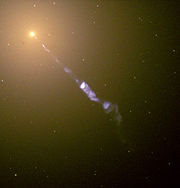
Messier 87
Messier 87 is a supergiant elliptical galaxy. It was discovered in 1781 by the French astronomer Charles Messier, who cataloged it as a nebulous feature. The second brightest galaxy within the northern Virgo Cluster, it is located about 16.4 million parsecs from Earth...
(Arp 152), however, the jets are ionized gas that has been ejected from the environment around supermassive black holes in the galaxies' active galactic nuclei. These jets, sometimes called relativistic jet
Relativistic jet
Relativistic jets are extremely powerful jets of plasma which emerge from presumed massive objects at the centers of some active galaxies, notably radio galaxies and quasars. Their lengths can reach several thousand or even hundreds of thousands of light years...
s or radio jets, are powerful sources of synchrotron
Synchrotron
A synchrotron is a particular type of cyclic particle accelerator in which the magnetic field and the electric field are carefully synchronised with the travelling particle beam. The proton synchrotron was originally conceived by Sir Marcus Oliphant...
radiation, especially at radio
Radio
Radio is the transmission of signals through free space by modulation of electromagnetic waves with frequencies below those of visible light. Electromagnetic radiation travels by means of oscillating electromagnetic fields that pass through the air and the vacuum of space...
wavelengths.
| Arp Number | Common Name | Notes |
|---|---|---|
| 149 | IC 803 | Interacting galaxies |
| 150 | NGC 7609 | Interacting galaxies |
| 151 | Arp 151 | Seyfert galaxy Seyfert galaxy Seyfert galaxies are a class of galaxies with nuclei that produce spectral line emission from highly ionized gas, named after Carl Keenan Seyfert, the astronomer who first identified the class in 1943... (contains an active galactic nucleus Active galactic nucleus An active galactic nucleus is a compact region at the centre of a galaxy that has a much higher than normal luminosity over at least some portion, and possibly all, of the electromagnetic spectrum. Such excess emission has been observed in the radio, infrared, optical, ultra-violet, X-ray and... ) |
| 152 | Messier 87 Messier 87 Messier 87 is a supergiant elliptical galaxy. It was discovered in 1781 by the French astronomer Charles Messier, who cataloged it as a nebulous feature. The second brightest galaxy within the northern Virgo Cluster, it is located about 16.4 million parsecs from Earth... |
Seyfert galaxy Seyfert galaxy Seyfert galaxies are a class of galaxies with nuclei that produce spectral line emission from highly ionized gas, named after Carl Keenan Seyfert, the astronomer who first identified the class in 1943... (contains an active galactic nucleus Active galactic nucleus An active galactic nucleus is a compact region at the centre of a galaxy that has a much higher than normal luminosity over at least some portion, and possibly all, of the electromagnetic spectrum. Such excess emission has been observed in the radio, infrared, optical, ultra-violet, X-ray and... ) |
Disturbed galaxies with interior absorption

.jpg)
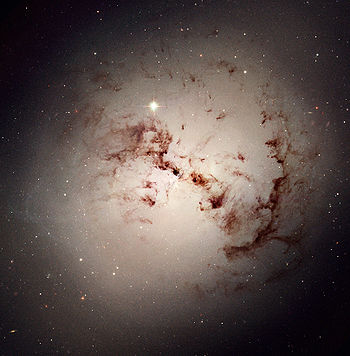
NGC 520
NGC 520 is a pair of colliding spiral galaxies about 90 million light-years away in the constellation Pisces. It has a H II nucleus.-External links:*...
(Arp 157) is one of the best examples of an intermediate-stage merger, where the two progenitor galaxies' disks have coalesced together but the nuclei have not. Centaurus A
Centaurus A
Centaurus A is a prominent galaxy in the constellation of Centaurus. There is considerable debate in the literature regarding the galaxy's fundamental properties such as its Hubble type and distance...
(Arp 153) and NGC 1316
NGC 1316
NGC 1316 is a lenticular galaxy about 70 million light-years away in the constellation Fornax. NGC 1316 is a radio galaxy. It is the fourth-brightest radio source in the sky .-Structure and formation:...
(Arp 154) are both effectively elliptical galaxies with unusual dust lanes; their kinematics and structure indicate that they have undergone merging events recently. NGC 4747 (Arp 159) may be nothing more than an edge-on spiral galaxy with a significantly dark dust lanes.
| Arp Number | Common Name | Notes |
|---|---|---|
| 153 | Centaurus A Centaurus A Centaurus A is a prominent galaxy in the constellation of Centaurus. There is considerable debate in the literature regarding the galaxy's fundamental properties such as its Hubble type and distance... |
Notable radio galaxy Radio galaxy Radio galaxies and their relatives, radio-loud quasars and blazars, are types of active galaxy that are very luminous at radio wavelengths, with luminosities up to 1039 W between 10 MHz and 100 GHz. The radio emission is due to the synchrotron process... ; contains an active galactic nucleus Active galactic nucleus An active galactic nucleus is a compact region at the centre of a galaxy that has a much higher than normal luminosity over at least some portion, and possibly all, of the electromagnetic spectrum. Such excess emission has been observed in the radio, infrared, optical, ultra-violet, X-ray and... ) |
| 154 | NGC 1316 NGC 1316 NGC 1316 is a lenticular galaxy about 70 million light-years away in the constellation Fornax. NGC 1316 is a radio galaxy. It is the fourth-brightest radio source in the sky .-Structure and formation:... |
Notable radio galaxy Radio galaxy Radio galaxies and their relatives, radio-loud quasars and blazars, are types of active galaxy that are very luminous at radio wavelengths, with luminosities up to 1039 W between 10 MHz and 100 GHz. The radio emission is due to the synchrotron process... ; contains an active galactic nucleus Active galactic nucleus An active galactic nucleus is a compact region at the centre of a galaxy that has a much higher than normal luminosity over at least some portion, and possibly all, of the electromagnetic spectrum. Such excess emission has been observed in the radio, infrared, optical, ultra-violet, X-ray and... ) |
| 155 | Arp 155 | |
| 156 | UGC 5184 | |
| 157 | NGC 520 NGC 520 NGC 520 is a pair of colliding spiral galaxies about 90 million light-years away in the constellation Pisces. It has a H II nucleus.-External links:*... |
Notable intermediate-stage merger |
| 158 | NGC 523 | |
| 159 | NGC 4747 | Spiral galaxy Spiral galaxy A spiral galaxy is a certain kind of galaxy originally described by Edwin Hubble in his 1936 work The Realm of the Nebulae and, as such, forms part of the Hubble sequence. Spiral galaxies consist of a flat, rotating disk containing stars, gas and dust, and a central concentration of stars known as... with dark dust lanes |
| 160 | NGC 4194 NGC 4194 NGC 4194 is pair of interacting galaxies in the constellation Ursa Major.... |
Also known as the Medusa Galaxy Merger |
Galaxies with diffuse filaments
The filaments in these objects may represent tidal tails from galaxy interactions. Many of the galaxies are the remnants of the mergers of two spiral galaxies to form a single elliptical galaxy. However, NGC 3414 (Arp 162) appears to be merely an unusual S0 galaxy with a very small disk relative to its bulge size. NGC 4670 (Arp 163) is a blue compact dwarf galaxyBlue compact dwarf galaxy
In astronomy, a blue compact dwarf galaxy is a small galaxy which contains large clusters of young, hot, massive stars. These stars cause the galaxy to appear blue in color. Since they exist mostly in clusters, blue compact dwarf galaxies don't have an exact uniform shape...
with extremely strong star formation activity
Star formation
Star formation is the process by which dense parts of molecular clouds collapse into a ball of plasma to form a star. As a branch of astronomy star formation includes the study of the interstellar medium and giant molecular clouds as precursors to the star formation process and the study of young...
; it is clearly too small to be the merger remnant of two spiral galaxies like the other merger remnants in this sample, although it may have been involved in a much smaller interaction.
| Arp Number | Common Name | Notes |
|---|---|---|
| 161 | UGC 6665 | |
| 162 | NGC 3414 | S0 galaxy |
| 163 | NGC 4670 | Blue compact dwarf galaxy Blue compact dwarf galaxy In astronomy, a blue compact dwarf galaxy is a small galaxy which contains large clusters of young, hot, massive stars. These stars cause the galaxy to appear blue in color. Since they exist mostly in clusters, blue compact dwarf galaxies don't have an exact uniform shape... |
| 164 | NGC 455 | |
| 165 | NGC 2418 | |
| 166 | NGC 750, NGC 751 | |
Galaxies with diffuse counter-tails
All of these objects are galaxies involved in gravitational interactions. These counter-tails are tidal features caused by the gravitational interactions between two galaxies, just like similar features described in the Arp catalog. Messier 32Messier 32
Messier 32 is a dwarf elliptical galaxy about 2.65 million light-years away in the constellation Andromeda. M32 is a satellite galaxy of the famous Andromeda Galaxy and was discovered by Le Gentil in 1749. M32 measures only 6.5 ± 0.2 kly in diameter at the widest point...
(Arp 168), a dwarf galaxy
Dwarf galaxy
A dwarf galaxy is a small galaxy composed of up to several billion stars, a small number compared to our own Milky Way's 200-400 billion stars...
interacting with the Andromeda Galaxy
Andromeda Galaxy
The Andromeda Galaxy is a spiral galaxy approximately 2.5 million light-years from Earth in the constellation Andromeda. It is also known as Messier 31, M31, or NGC 224, and is often referred to as the Great Andromeda Nebula in older texts. Andromeda is the nearest spiral galaxy to the...
, is included in this category (although the "diffuse counter-tail" is very difficult to see in Arp's photograph).
| Arp Number | Common Name | Notes |
|---|---|---|
| 167 | NGC 2672, NGC 2673 | |
| 168 | Messier 32 Messier 32 Messier 32 is a dwarf elliptical galaxy about 2.65 million light-years away in the constellation Andromeda. M32 is a satellite galaxy of the famous Andromeda Galaxy and was discovered by Le Gentil in 1749. M32 measures only 6.5 ± 0.2 kly in diameter at the widest point... |
Dwarf galaxy Dwarf galaxy A dwarf galaxy is a small galaxy composed of up to several billion stars, a small number compared to our own Milky Way's 200-400 billion stars... interacting with Andromeda Galaxy Andromeda Galaxy The Andromeda Galaxy is a spiral galaxy approximately 2.5 million light-years from Earth in the constellation Andromeda. It is also known as Messier 31, M31, or NGC 224, and is often referred to as the Great Andromeda Nebula in older texts. Andromeda is the nearest spiral galaxy to the... |
| 169 | NGC 7236, NGC 7237, NGC 7237C | Galaxy triplet |
| 170 | NGC 7578 | |
| 171 | NGC 5718, IC 1042 | |
| 172 | IC 1178, IC 1181 | |
Galaxies with narrow counter-tails
This is another category containing galaxies with tidal tails produced by gravitational interactions. These tidal tails are narrower and better defined than the tidal tails in objects 167-172.| Arp Number | Common Name | Notes |
|---|---|---|
| 173 | UGC 9561 UGC 9561 UGC 9561 is a galaxy in the constellation Boötes. It is part of the Arp 173 pair of galaxies, with MCG+02-38-020.-References:* * * * * *... |
|
| 174 | NGC 3068 | |
| 175 | IC 3481, IC 3481A, IC 3483 | Galaxy triplet |
| 176 | NGC 4933 | Galaxy triplet |
| 177 | Arp 177 Arp 177 Arp 177, APG 177 or VV 840 is a group of galaxies in the constellation Boötes.It is composed of:* MCG 4-35-17* MCG 4-35-16- References :*... |
|
| 178 Arp 178 Arp 178 is a triplet of galaxies, in the constellation Boötes: * NGC 5613* NGC 5614* NGC 5615... |
NGC 5613 NGC 5613 NGC 5613 is galaxy in the constellation Boötes. It is part of the Arp 178 set of interacting galaxies, with NGC 5615 and NGC 5614.-References:* * *... , NGC 5614 NGC 5614 NGC 5614 is galaxy in the constellation Boötes. It is part of the Arp 178 triplet of interacting galaxies with NGC 5613 and NGC 5615.-References:* * * *... , NGC 5615 NGC 5615 NGC 5615 is a galaxy in the constellation Boötes. It is part of the Arp 178 triplet of interacting galaxies with NGC 5614 and NGC 5613.-References:***... |
Galaxy triplet |
Galaxies with narrow filaments
.jpg)
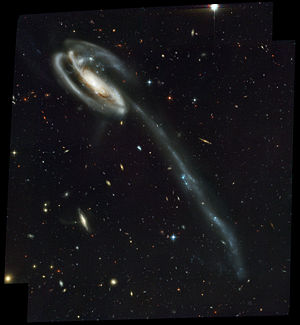
| Arp Number | Common Name | Notes |
|---|---|---|
| 179 | Arp 179 | |
| 180 | Arp 180 | Interacting galaxy pair |
| 181 | NGC 3212, NGC 3215 | Interacting galaxy pair |
| 182 | NGC 7674, NGC 7674A | Interacting galaxy pair |
| 183 | UGC 8560 | Spiral galaxy Spiral galaxy A spiral galaxy is a certain kind of galaxy originally described by Edwin Hubble in his 1936 work The Realm of the Nebulae and, as such, forms part of the Hubble sequence. Spiral galaxies consist of a flat, rotating disk containing stars, gas and dust, and a central concentration of stars known as... |
| 184 | NGC 1961 | Spiral galaxy Spiral galaxy A spiral galaxy is a certain kind of galaxy originally described by Edwin Hubble in his 1936 work The Realm of the Nebulae and, as such, forms part of the Hubble sequence. Spiral galaxies consist of a flat, rotating disk containing stars, gas and dust, and a central concentration of stars known as... |
| 185 | NGC 6217 | Spiral galaxy Spiral galaxy A spiral galaxy is a certain kind of galaxy originally described by Edwin Hubble in his 1936 work The Realm of the Nebulae and, as such, forms part of the Hubble sequence. Spiral galaxies consist of a flat, rotating disk containing stars, gas and dust, and a central concentration of stars known as... |
| 186 | NGC 1614 | Spiral galaxy Spiral galaxy A spiral galaxy is a certain kind of galaxy originally described by Edwin Hubble in his 1936 work The Realm of the Nebulae and, as such, forms part of the Hubble sequence. Spiral galaxies consist of a flat, rotating disk containing stars, gas and dust, and a central concentration of stars known as... involved in recent interaction |
| 187 | Arp 187 Arp 187 Arp 187 is a radio galaxy located in the constellation Eridanus. It is an interacting galaxy pair .-External links:*... |
|
| 188 | Tadpole Galaxy Tadpole Galaxy The Tadpole Galaxy is a disrupted barred spiral galaxy located 400 million light years from Earth toward the northern constellation Draco. Its most dramatic features are a trail of stars about 280 thousand light-years long and massive, bright blue star clusters.It is hypothesized that a more... |
Galaxy involved in recent interaction |
| 189 | NGC 4651 | Tidal star streams |
| 190 | UGC 2320 UGC 2320 -References:* * * *... |
Interacting galaxy pair |
| 191 | UGC 6175 | Interacting galaxy pair |
| 192 | NGC 3303 | Interacting galaxy pair |
| 193 | IC 883 | Merger remnant |
Galaxies with material ejected from nuclei

NGC 5544
NGC 5544 is galaxy in the constellation Boötes. Interacting galaxies, NGC 5544 and NGC 5545.-References:***...
and NGC 5545
NGC 5545
NGC 5545 is a galaxy in the constellation Boötes. It is a single galaxy in pair of galaxies.-References:* * *...
in Arp 199), the "ejecta" are clearly a spiral galaxy viewed edge-on that happens to line up with another galaxy's nucleus.
Almost all of the objects in this category are interacting or have recently undergone interactions. NGC 3712 (Arp 203) is an exception; it is merely a low surface brightness spiral galaxy.
| Arp Number | Common Name | Notes |
|---|---|---|
| 194 | UGC 6945 | Interacting galaxy pair |
| 195 | UGC 4653 | Interacting galaxy triplet |
| 196 | Arp 196 | Interacting galaxy pair |
| 197 | UGC 6503, IC 701 | Interacting galaxy pair |
| 198 | UGC 6073 | Interacting galaxy pair |
| 199 | NGC 5544 NGC 5544 NGC 5544 is galaxy in the constellation Boötes. Interacting galaxies, NGC 5544 and NGC 5545.-References:***... , NGC 5545 NGC 5545 NGC 5545 is a galaxy in the constellation Boötes. It is a single galaxy in pair of galaxies.-References:* * *... |
Interacting galaxy pair |
| 200 | NGC 1134 NGC 1134 -References:* *... |
Spiral galaxy Spiral galaxy A spiral galaxy is a certain kind of galaxy originally described by Edwin Hubble in his 1936 work The Realm of the Nebulae and, as such, forms part of the Hubble sequence. Spiral galaxies consist of a flat, rotating disk containing stars, gas and dust, and a central concentration of stars known as... interacting with low surface brightness galaxy |
| 201 | UGC 224 | Interacting galaxy pair |
| 202 | NGC 2719, NGC 2719A | Interacting galaxy pair |
| 203 | NGC 3712 | Low surface brightness spiral galaxy Spiral galaxy A spiral galaxy is a certain kind of galaxy originally described by Edwin Hubble in his 1936 work The Realm of the Nebulae and, as such, forms part of the Hubble sequence. Spiral galaxies consist of a flat, rotating disk containing stars, gas and dust, and a central concentration of stars known as... |
| 204 | UGC 8454 | Interacting galaxy pair |
| 205 | NGC 3448 | Merger remnant |
| 206 | UGC 5983, NGC 3432 | Interacting galaxy pair |
| 207 | UGC 5050 | Spiral galaxy Spiral galaxy A spiral galaxy is a certain kind of galaxy originally described by Edwin Hubble in his 1936 work The Realm of the Nebulae and, as such, forms part of the Hubble sequence. Spiral galaxies consist of a flat, rotating disk containing stars, gas and dust, and a central concentration of stars known as... interacting with dwarf galaxy Dwarf galaxy A dwarf galaxy is a small galaxy composed of up to several billion stars, a small number compared to our own Milky Way's 200-400 billion stars... |
| 208 | Arp 208 | Interacting galaxy pair |
Galaxies with irregularities, absorption, and resolution

| Arp Number | Common Name | Notes |
|---|---|---|
| 209 | NGC 6052 | Interacting galaxy pair |
| 210 | NGC 1569 NGC 1569 NGC 1569 is a dwarf irregular galaxy in Camelopardalis. While this faint galaxy is not a popular amateur astronomy target, it is well studied by professional astronomers, who are interested in the history of star formation within the galaxy. The galaxy is relatively nearby. Consequently, the... |
Dwarf galaxy Dwarf galaxy A dwarf galaxy is a small galaxy composed of up to several billion stars, a small number compared to our own Milky Way's 200-400 billion stars... |
| 211 | UGCA 290 | Interacting dwarf galaxies |
| 212 | NGC 7625 | Peculiar spiral galaxy Spiral galaxy A spiral galaxy is a certain kind of galaxy originally described by Edwin Hubble in his 1936 work The Realm of the Nebulae and, as such, forms part of the Hubble sequence. Spiral galaxies consist of a flat, rotating disk containing stars, gas and dust, and a central concentration of stars known as... |
| 213 | IC 356 | Peculiar spiral galaxy Spiral galaxy A spiral galaxy is a certain kind of galaxy originally described by Edwin Hubble in his 1936 work The Realm of the Nebulae and, as such, forms part of the Hubble sequence. Spiral galaxies consist of a flat, rotating disk containing stars, gas and dust, and a central concentration of stars known as... |
| 214 | NGC 3718 | Peculiar spiral galaxy Spiral galaxy A spiral galaxy is a certain kind of galaxy originally described by Edwin Hubble in his 1936 work The Realm of the Nebulae and, as such, forms part of the Hubble sequence. Spiral galaxies consist of a flat, rotating disk containing stars, gas and dust, and a central concentration of stars known as... |
Galaxies with adjacent loops

Arp 220
Arp 220 is the result of a collision between two galaxies which are now in the process of merging. Located 250 million light-years away in the constellation Serpens, it is the 220th object in Halton Arp's Atlas of Peculiar Galaxies.-Features:...
, one of the best-studied ultraluminous infrared galaxies in the sky.
| Arp Number | Common Name | Notes |
|---|---|---|
| 215 | NGC 2782 | Peculiar spiral galaxy Spiral galaxy A spiral galaxy is a certain kind of galaxy originally described by Edwin Hubble in his 1936 work The Realm of the Nebulae and, as such, forms part of the Hubble sequence. Spiral galaxies consist of a flat, rotating disk containing stars, gas and dust, and a central concentration of stars known as... |
| 216 | NGC 7679, NGC 7682 | Interacting galaxy pair |
| 217 | NGC 3310 NGC 3310 NGC 3310 is a grand design spiral galaxy in the constellation Ursa Major. It is a starburst galaxy and its likely that NGC 3310 collided with one of its satellite galaxies about 100 million years ago, triggering widespread star formation... |
Notable nearby starburst Starburst (astronomy) In astronomy, starburst is a generic term to describe a region of space with an abnormally high rate of star formation. It is reserved for truly unusual objects.... ; merger remnant |
| 218 | Arp 218 | Interacting galaxy pair |
| 219 | UGC 2812 | Galaxy in interaction |
| 220 | Arp 220 Arp 220 Arp 220 is the result of a collision between two galaxies which are now in the process of merging. Located 250 million light-years away in the constellation Serpens, it is the 220th object in Halton Arp's Atlas of Peculiar Galaxies.-Features:... |
Merger remnant; notable ultraluminous infrared galaxy |
Galaxies with amorphous spiral arms

| Arp Number | Common Name | Notes |
|---|---|---|
| 221 | Arp 221 | Interacting galaxy triplet |
| 222 | NGC 7727 | Merger remnant |
| 223 | NGC 7585 | Recent inequal-mass merger |
| 224 | NGC 3921 | Merger remnant |
| 225 | NGC 2655 | Recent inequal-mass merger |
| 226 | The Atoms for Peace Galaxy (NGC 7252 NGC 7252 NGC 7252 is a peculiar galaxy resulting from an interaction between two galaxies that started a billion years ago. It is located 220 million light years away in the constellation Aquarius... ) |
Merger remnant |
Galaxies with concentric rings
These are galaxies with shell-like structures. Some shell structures have been identified as the results of recent mergers. In other cases, however, the shell structure may represent the outer disk of an S0 galaxy. In some complicated cases, the galaxy with the rings or shells is an S0 galaxy interacting with another galaxy; the origins of the shells in such systems can be difficult to determine.| Arp Number | Common Name | Notes |
|---|---|---|
| 227 | NGC 470, NGC 474 NGC 474 NGC 474 is an elliptical galaxy about 100 million light years distant in the constellation pisces. This large galaxy is known to possess tidal tails, although their origins remain unknown.-Further reading:... |
Interacting galaxy pair with one S0 galaxy |
| 228 | IC 162 | S0 galaxy |
| 229 | NGC 507, NGC 508 | Interacting galaxy pair including one S0 galaxy and one elliptical galaxy Elliptical galaxy An elliptical galaxy is a galaxy having an approximately ellipsoidal shape and a smooth, nearly featureless brightness profile. They range in shape from nearly spherical to highly flat and in size from hundreds of millions to over one trillion stars... |
| 230 | IC 51 | Peculiar S0 galaxy; possible merger remnant |
| 231 | IC 1575 | |
| 232 | NGC 2911 | Peculiar S0 galaxy |
Galaxies with the appearance of fission
.jpg)
.jpg)
.jpg)
Antennae Galaxies
The Antennae Galaxies are a pair of interacting galaxies in the constellation Corvus. They are currently going through a phase of starburst. They were discovered by William Herschel in 1785...
(NGC 4038 and NGC 4039, Arp 244) and the Mice Galaxies
Mice Galaxies
NGC 4676, or the Mice Galaxies, are two spiral galaxies in the constellation Coma Berenices. About 290 million light-years away, they are presently in the process of colliding and merging...
(NGC 4676, Arp 242).
However, not all of these objects are interacting galaxies. A few of these galaxies are simply nearby dwarf galaxies with irregular structure.
| Arp Number | Common Name | Notes |
|---|---|---|
| 233 | UGC 5720 | Dwarf galaxy Dwarf galaxy A dwarf galaxy is a small galaxy composed of up to several billion stars, a small number compared to our own Milky Way's 200-400 billion stars... |
| 234 | NGC 3738 | Dwarf galaxy Dwarf galaxy A dwarf galaxy is a small galaxy composed of up to several billion stars, a small number compared to our own Milky Way's 200-400 billion stars... |
| 235 | NGC 14 | Dwarf galaxy Dwarf galaxy A dwarf galaxy is a small galaxy composed of up to several billion stars, a small number compared to our own Milky Way's 200-400 billion stars... |
| 236 | IC 1623 | Interacting galaxy pair |
| 237 | UGC 5044 | Interacting galaxy pair |
| 238 | UGC 8335 | Interacting galaxy pair |
| 239 | NGC 5278, NGC 5279 | Interacting galaxy pair |
| 240 Arp 240 Arp 240 applies to two galaxies in a galaxy pair:*NGC 5257*NGC 5258... |
NGC 5257 NGC 5257 NGC 5257 is a spiral galaxy located in the constellation Virgo. The galaxy is notably interacting with the spiral galaxy NGC 5258. The two galaxies are listed together as Arp 240 in the Atlas of Peculiar Galaxies. Both galaxies are distorted by the gravitational interaction, and both are... , NGC 5258 NGC 5258 NGC 5258 is a spiral galaxy located in the constellation Virgo. The galaxy is notably interacting with the spiral galaxy NGC 5257. The two galaxies are listed together as Arp 240 in the Atlas of Peculiar Galaxies. Both galaxies are distorted by the gravitational interaction, and both are... |
Interacting galaxy pair |
| 241 | UGC 9425 UGC 9425 -References:* *... |
Interacting galaxy pair |
| 242 | Mice Galaxies Mice Galaxies NGC 4676, or the Mice Galaxies, are two spiral galaxies in the constellation Coma Berenices. About 290 million light-years away, they are presently in the process of colliding and merging... (NGC 4676) |
Interacting galaxy pair |
| 243 | NGC 2623 | Interacting galaxy triplet |
| 244 | Antennae Galaxies Antennae Galaxies The Antennae Galaxies are a pair of interacting galaxies in the constellation Corvus. They are currently going through a phase of starburst. They were discovered by William Herschel in 1785... (NGC 4038, NGC 4039) |
Interacting galaxy pair |
| 245 | NGC 2992, NGC 2993 | Interacting galaxy pair |
| 246 | NGC 7837, NGC 7838 | Interacting galaxy pair |
| 247 | UGC 4383 | Interacting galaxy pair |
| 248 | Arp 248 | Interacting galaxy triplet |
| 249 | UGC 12891 | Interacting galaxy pair |
| 250 | Arp 250 | |
| 251 | Arp 251 | Interacting galaxy triplet |
| 252 | Arp 252 | Interacting galaxy pair |
| 253 | UGCA 173, UGCA 174 | Interacting galaxy pair |
| 254 | NGC 5917 | Peculiar spiral galaxy Spiral galaxy A spiral galaxy is a certain kind of galaxy originally described by Edwin Hubble in his 1936 work The Realm of the Nebulae and, as such, forms part of the Hubble sequence. Spiral galaxies consist of a flat, rotating disk containing stars, gas and dust, and a central concentration of stars known as... |
| 255 | UGC 5304 | Interacting galaxy pair |
| 256 | Arp 256 | Interacting galaxy pair |
Galaxies with irregular clumps

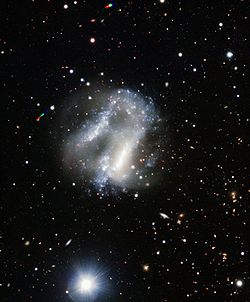
| Arp Number | Common Name | Notes |
|---|---|---|
| 257 | UGC 4836 | Interacting galaxy pair |
| 258 | UGC 2140 UGC 2140 -References:* *... |
Galaxy group |
| 259 | NGC 1741 | Galaxy group |
| 260 | UGC 7230 | Interacting galaxy pair |
| 261 | Arp 261 | Galaxy group |
| 262 | Arp 262 | Interacting galaxy pair |
| 263 | NGC 3239 | Dwarf galaxy Dwarf galaxy A dwarf galaxy is a small galaxy composed of up to several billion stars, a small number compared to our own Milky Way's 200-400 billion stars... |
| 264 | NGC 3104 | Dwarf galaxy Dwarf galaxy A dwarf galaxy is a small galaxy composed of up to several billion stars, a small number compared to our own Milky Way's 200-400 billion stars... |
| 265 | IC 3862 | Interacting galaxy pair |
| 266 | NGC 4861 | Dwarf galaxy Dwarf galaxy A dwarf galaxy is a small galaxy composed of up to several billion stars, a small number compared to our own Milky Way's 200-400 billion stars... |
| 267 | UGC 5746 | Dwarf galaxy Dwarf galaxy A dwarf galaxy is a small galaxy composed of up to several billion stars, a small number compared to our own Milky Way's 200-400 billion stars... |
| 268 | Holmberg II | Dwarf galaxy Dwarf galaxy A dwarf galaxy is a small galaxy composed of up to several billion stars, a small number compared to our own Milky Way's 200-400 billion stars... |
Double and multiple galaxies
Arp originally referred to these galaxies as "double galaxies", but many of these sources are more than two galaxies. Some of the objects consist of interacting galaxies, whereas other sources are actually groups of galaxies. The difference is that interacting galaxies will be distorted, whereas galaxies in groups are simply gravitationally bound to each other but not necessarily close enough to each other to induce major structural changes.Galaxies with connected arms
.jpg)
The connected arms described here are tidal bridge features that form between interacting galaxies. These bridges form early during galaxy interactions.
| Arp Number | Common Name | Notes |
|---|---|---|
| 269 | NGC 4485, NGC 4490 | Interacting galaxy pair |
| 270 | NGC 3395, NGC 3396 | Interacting galaxy pair |
| 271 Arp 271 NGC 5426 and NGC 5427 are two spiral galaxies of similar sizes engaged in a dramatic dance. It is not certain that this interaction will end in a collision and ultimately a merging of the two galaxies, although the galaxies have already been affected... |
NGC 5426, NGC 5427 | Interacting galaxy pair |
| 272 Arp 272 Arp 272 is a pair of colliding galaxies consisting of the two spiral galaxies NGC 6050 and IC 1179 and lies around 450 million light years from Earth in the constellation of Hercules... |
NGC 6050, IC 1179 | Interacting galaxy pair |
| 273 Arp 273 Arp 273 is a group of interacting galaxies, lying 300 million light years away in the constellation Andromeda. It was first described in the Atlas of Peculiar Galaxies, compiled by Halton Arp in 1966. The larger of the spiral galaxies, known as UGC 1810, is about five times heavier... |
UGC 1810, UGC 1813 | Interacting galaxy pair |
| 274 | NGC 5679 | Interacting galaxy triplet |
Interacting galaxies
Unlike many of the objects listed in the amorphous galaxies section, the interacting galaxies that comprise these objects are still distinguishable from each other.| Arp Number | Common Name | Notes |
|---|---|---|
| 275 | NGC 2881 | Interacting galaxy pair |
| 276 Arp 276 Arp 276 is a pair of interacting galaxies NGC 935 and IC 1801 within the Aries constellation. NGC 935 is the northern member of the pair and IC 1801 is the southern.-References:* *... |
NGC 935, IC 1801 | Interacting galaxy pair |
| 277 | NGC 4809, NGC 4810 | Interacting galaxy pair |
| 278 | NGC 7253 | Interacting galaxy pair |
| 279 | NGC 1253, NGC 1253A | Interacting galaxy pair |
| 280 | NGC 3769, NGC 3769A | Interacting galaxy pair |
Galaxies with infall and attraction
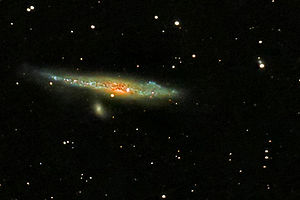
| Arp Number | Common Name | Notes |
|---|---|---|
| 281 | NGC 4627 NGC 4627 NGC 4627 is a dwarf elliptical galaxy in the constellation Canes Venatici.... , NGC 4631 NGC 4631 NGC 4631 is an edge-on spiral galaxy in the constellation Canes Venatici. This galaxy's slightly distorted wedge shape gives it the appearance of a herring or a whale, whence its nickname... |
Spiral galaxy Spiral galaxy A spiral galaxy is a certain kind of galaxy originally described by Edwin Hubble in his 1936 work The Realm of the Nebulae and, as such, forms part of the Hubble sequence. Spiral galaxies consist of a flat, rotating disk containing stars, gas and dust, and a central concentration of stars known as... with companion dwarf elliptical galaxy Elliptical galaxy An elliptical galaxy is a galaxy having an approximately ellipsoidal shape and a smooth, nearly featureless brightness profile. They range in shape from nearly spherical to highly flat and in size from hundreds of millions to over one trillion stars... |
| 282 | NGC 169, NGC 169A | Spiral galaxy Spiral galaxy A spiral galaxy is a certain kind of galaxy originally described by Edwin Hubble in his 1936 work The Realm of the Nebulae and, as such, forms part of the Hubble sequence. Spiral galaxies consist of a flat, rotating disk containing stars, gas and dust, and a central concentration of stars known as... with smaller companion galaxy |
| 283 | NGC 2798, NGC 2799 | Interacting galaxy pair |
| 284 | NGC 7714 NGC 7714 NGC 7714 spiral galaxy in the constellation Pisces. It was discovered by John Herschel on 18 September 1830.NGC 7714 and NGC 7715 are interacting galaxies. The pair are also known as Arp 284. NGC 7714 appears to be a highly distorted spiral, possibly a barred spiral galaxy... , NGC 7715 |
Interacting galaxy pair |
| 285 | NGC 2854, NGC 2856 | Galaxy pair |
| 286 | NGC 5560, NGC 5566, NGC 5569 | Interacting galaxy triplet |
Galaxies with wind effects
Although included in the double galaxies category, many of these objects are individual galaxies. The "wind effects" refer to the appearance, not the actual detection of high-velocity gas (such as is found in M82Messier 82
Messier 82 is the prototype nearby starburst galaxy about 12 million light-years away in the constellation Ursa Major...
). In some cases, the appearance may be the result of interaction. In other cases, particularly NGC 3981 (Arp 289), the faint, extended emission may be related to the intrinsic nature of the galaxy itself and not interactions with other objects.
| Arp Number | Common Name | Notes |
|---|---|---|
| 287 | NGC 2735, NGC 2735A | Galaxy pair |
| 288 | NGC 5221, NGC 5222 | Galaxy triplet |
| 289 | NGC 3981 | Peculiar spiral galaxy Spiral galaxy A spiral galaxy is a certain kind of galaxy originally described by Edwin Hubble in his 1936 work The Realm of the Nebulae and, as such, forms part of the Hubble sequence. Spiral galaxies consist of a flat, rotating disk containing stars, gas and dust, and a central concentration of stars known as... |
| 290 | IC 195 IC 195 -References:* *... , IC 196 |
Interacting galaxy pair |
| 291 | UGC 5832 | Irregular galaxy Irregular galaxy An irregular galaxy is a galaxy that does not have a distinct regular shape, like a spiral or an elliptical galaxy. The shape of an irregular galaxy is uncommon – they do not fall into any of the regular classes of the Hubble sequence, and they are often chaotic in appearance, with neither a... |
| 292 | IC 575 | Peculiar spiral galaxy Spiral galaxy A spiral galaxy is a certain kind of galaxy originally described by Edwin Hubble in his 1936 work The Realm of the Nebulae and, as such, forms part of the Hubble sequence. Spiral galaxies consist of a flat, rotating disk containing stars, gas and dust, and a central concentration of stars known as... |
| 293 | NGC 6285, NGC 6286 | Interacting galaxy pair |
Double or multiple galaxies with long filaments
.jpg)
| Arp Number | Common Name | Notes |
|---|---|---|
| 294 | NGC 3786, NGC 3788 | Interacting galaxy pair |
| 295 | Arp 295 | Interacting galaxy pair |
| 296 | Arp 296 | |
| 297 | Arp 297 Arp 297 Arp 297 is a quartet of galaxies, in the constellation Boötes:* NGC 5752* NGC 5753* NGC 5754* NGC 5755... |
Interacting galaxies within a galaxy group |
Unclassified objects
.jpg)
.jpg)
| Arp Number | Common Name | Description |
|---|---|---|
| 298 | NGC 7469, IC 5283 | Galaxy pair |
| 299 | Arp 299 Arp 299 Arp 299 is a set of galaxies approximately 134 million light-years away in the constellation Ursa Major.Both of the galaxies involved in the collision are barred irregular galaxies.... |
Galaxy triplet |
| 300 | Arp 300 | Galaxy group |
| 301 | UGC 6204, UGC 6207 | Galaxy pair |
| 302 | UGC 9618 UGC 9618 UGC 9618 is a galaxy in the constellation Boötes. UGC 9618, also known as VV 340 or Arp 302 consists of a pair of very gas-rich spiral galaxies in their early stages of interaction. An enormous amount of infrared light is radiated by the gas from massive stars that are forming at a rate similar to... |
Galaxy pair |
| 303 | IC 563, IC 564 | Galaxy pair |
| 304 | NGC 1241, NGC 1242 | Galaxy pair |
| 305 | NGC 4016, NGC 4017 | Galaxy pair |
| 306 | Arp 306 | Galaxy group with two galaxy pairs |
| 307 | NGC 2872, NGC 2874 | Galaxy pair |
| 308 | NGC 545, NGC 547 | Galaxy pair |
| 309 | NGC 942, NGC 943 | Galaxy pair |
| 310 | IC 1259 | Galaxy pair |
Groups of galaxies
| Arp Number | Common Name | Description |
|---|---|---|
| 311 | IC 1258 and Companions | |
| 312 | MCG +08-31-004 | |
| 313 | NGC 3994 + NGC 3995 | |
| 314 | MCG -03-58-009 + MCG -03-58-010 + MCG -03-58-011 | |
| 315 | NGC 2830 + NGC 2831 + NGC 2832 | |
| 316 | NGC 3193 | |
| 317 | Leo Triplet Leo Triplet The Leo Triplet is a small group of galaxies about 35 million light-years away in the constellation Leo. This galaxy group consists of the spiral galaxies M65, the M66, and the NGC 3628.-Members:... |
|
| 318 | NGC 833 and companions | |
| 319 | Stephan's Quintet Stephan's Quintet Stephan's Quintet in the constellation Pegasus is a visual grouping of five galaxies of which four form the first compact galaxy group ever discovered. The group was discovered by Édouard Stephan in 1877 at Marseilles Observatory.... |
|
| 320 | Copeland's Septet | |
| 321 | Hickson 40 A-E | |
Chains of galaxies
| Arp Number | Common Name | Description |
|---|---|---|
| 322 | UGC 6527 | |
| 323 | Hickson 98 A-D | |
| 324 | UGC 10143 | |
| 325 | ESO601-G018A+B and MCG -04-52-014 | |
| 326 | UGC 8610 | |
| 327 | NGC 1875; Hickson 34 A-D | |
| 328 | UGC 9532; Hickson 72 | |
| 329 | UGC 6514 | |
| 330 | I Zw 167; MCG +09-27-094 | |
| 331 | NGC 379 and companions (Pisces Cloud) | |
| 332 | NGC 1228 | |
Miscellaneous
| Arp Number | Common Name | Description |
|---|---|---|
| 333 | NGC 1024 | |
| 334 | UGC 8498 | |
| 335 | NGC 3509 | |
| 336 | NGC 2685 | |
| 337 | Messier 82 Messier 82 Messier 82 is the prototype nearby starburst galaxy about 12 million light-years away in the constellation Ursa Major... |
|
| 338 | PGC 3094767 | |
Brightest Arp galaxies for amateur astronomers
Maynard PittendreighMaynard Pittendreigh
The Rev. Dr. W. Maynard Pittendreigh is an astronomer, writer and an ordained minister in the Presbyterian Church . As a minister, he has been a pioneer and leader in a movement toward multi-cultural/racial congregations, and in developing early Internet-based ministries.William Maynard...
, an amateur astronomer and occasional writer, has compiled a list of the brightest Arp Galaxies that are most easily viewed by typical amateur astronomers. The galaxies on the list can be observed visually and do not require special photographic or imaging equipment. These include:
- Arp 26, also known as M 101
- Arp 37, also known as M 77
- Arp 76, also known as M 90
- Arp 77
- Arp 85, also known as M 51
- Arp 116, also known as M 60
- Arp 120
- Arp 152, also known as M 87
- Arp 153
- Arp 168, also known as M 32
- Arp 244
- Arp 269
- Arp 270
- Arp 271Arp 271NGC 5426 and NGC 5427 are two spiral galaxies of similar sizes engaged in a dramatic dance. It is not certain that this interaction will end in a collision and ultimately a merging of the two galaxies, although the galaxies have already been affected...
- Arp 281
- Arp 286
- Arp 317, also known as M 65
- Arp 313
- Arp 337, also known as M 82
See also
- Index CatalogueIndex CatalogueThe Index Catalogue —also known as the Index Catalogue of Nebulae, the Index Catalogue of Nebulae and Clusters of Stars, IC I, or IC II— is a catalogue of galaxies, nebulae and star clusters that serves as a supplement to the New General Catalogue...
(IC) - Messier objectMessier objectThe Messier objects are a set of astronomical objects first listed by French astronomer Charles Messier in 1771. The original motivation of the catalogue was that Messier was a comet hunter, and was frustrated by objects which resembled but were not comets...
(M) - New General CatalogueNew General CatalogueThe New General Catalogue of Nebulae and Clusters of Stars is a well-known catalogue of deep sky objects in astronomy. It contains 7,840 objects, known as the NGC objects...
(NGC) - Uppsala General CatalogueUppsala General CatalogueThe Uppsala General Catalogue of Galaxies is a catalogue of 12921 galaxies visible from the northern hemisphere. It was published the first time in 1973....
(UGC)
Further reading
- J. Kanipe, D. Webb The Arp Atlas of Peculiar Galaxies, A Chronicle and Observer's Guide, Willmann-Bell Inc. (2006) ISBN 978-0-943396-76-7
External links
- Amateur observations of the galaxies
- Earthlings - Astronomy web site Paul and Liz Downing
- Grasslands Observatory Arp Galaxies
- Dick Miller's images of all 338 Arps
- Information for observing Arp Peculiar Galaxies
- Hubble Images Peculiar Galaxy Pair Arp 87
- NASA/IPAC Extragalactic Database Electronic Copy of the Atlas of Peculiar Galaxies

